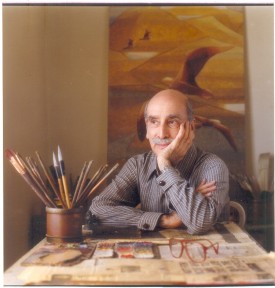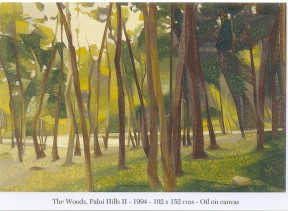When the National Gallery of Modern Art in Delhi had hosted a retrospective exhibition of Jehangir Sabavala, one of India’s most distinguished figurative artists, in 2006, the 84-year-old had regaled his audience with a fabulous one liner: “There was a time when I was paid a few hundred rupees for my work and that too in instalments. This retrospective means I am now a successful artist!”
Successful is indeed an underestimation for the iconic artist – he set a new personal record when his painting The Casuarina Line I sold for Rs 1.7 crore at Saffronart’s summer online auction last year – who passed away today at Breach Candy hospital in Mumbai after a long drawn battle with lung cancer.
Born in 1922 in Mumbai, Sabavala had an exceptional training in art education. After his initial years at J.J. School of Art, Mumbai, he went to London in 1945 to train at the Heatherley School of Art and in 1947, moved to Paris to study at the Academic Julian and the Academic Andre Lhote where he remained till 1951. In 1954, he showed at the Venice Biennale and this was the first time an Indian painter’s work had found so much recognition outside the Asian sub-continent. Winner of the Padma Shri award in 1977, Sabavala received many honours including the Lalit Kala Ratna in 2007.
Known for his impressionist and cubist textures, Sabavala’s forte was in creating serene landscapes and seascapes. His colour palette was soft and muted and the mood always tranquil. While he was admired mostly for his landscapes, he was equally adept at handling the transparency of water creating the soothing effect with veiled light and middle tones and subtle colouring. An artist practicing in the modernist style with a deeply ingrained classical influence, Sabavala created geometric wedges out of paint, which he put together to form vast, tranquil scenes. These ‘receding planes’ gave each canvas an illusory sense of depth, illustrating Sabavala’s mastery over light, colour, and texture.
In the artist’s early works, the human form emerged as only a minuscule element on the canvas, shrouded in silence and encapsulating the notion of solitude perfectly. However, his figures, over the many years that Sabavala painted, had begun to reveal more and more of themselves, even though they were still distanced from the viewer.
As art curator Ranjit Hoskote, who authored Sabavala’s definitive biography in 1998 writes, “Classicist though he is, Sabavala has loosened up in his recent work. He has pitched his palette higher, delighted in bright, efflorescent, and even florescent colours. He has opened up his frames, more accustomed to pictorial meditations on lakes and oceans, to include the concrete and glass reality of Mumbai’s skyscrapers. And he has once again focused on archetypal figures as well as his timeless landscapes, always mysterious in their crystalline geometry.”
Sabavala’s career spanned more than 60 years since his first solo exhibition held in a hired room of the Taj Mahal Hotel in Mumbai, put up with the help of fellow artist MF Husain and a couple of carpenters. To the artist’s credit are over 30 solo exhibitions held across India as well as abroad. His most recent solo exhibits include Ricorso at Aicon Gallery, New York, in 2009 and Sakshi Gallery, Mumbai, in 2008; and ‘Jehangir Sabavala: A Retrospective’ organized by Sakshi Gallery at the National Gallery of Modern Art, Mumbai and New Delhi, in 2005-06. Sabavala’s works have also been featured in numerous group exhibitions all over the world. Hs work is in several important collections, both private and public, in India and abroad. A National Award winning film Colours of Absence was made on his life and work by the documentary film maker Arun Khopkar in 1993.
To quote what Jehangir Sabavala had once said about his work: “It has been a long and arduous journey, but one that has steadily evolved, without harsh leaps or suicidal reverses. My graph is easily deciphered from the start to where it stands today. I am essentially a figurative painter with a strong predilection towards landscape. It is central to my work, and yet, the figure whether wraithlike or human, is often present as a part of the whole. ”
His career can be best described as a steady progression, a journey “with the paintings as steps, in a difficult, highly formulized pilgrimage towards a metaphysical truth”.
Poonam Goel is a freelance journalist and has covered the arts for over 15 years. She contributes on visual arts for various newspapers, magazines and online media. More about her on Story Wallahs. Write to her @ poonamgoel2410@gmail.com








One more shocking news to the art-lovers…in addition to MFHusain’s; the void left by Husain & Sabavala’s death could not be filled. Poonam’s tribute touches our hearts.